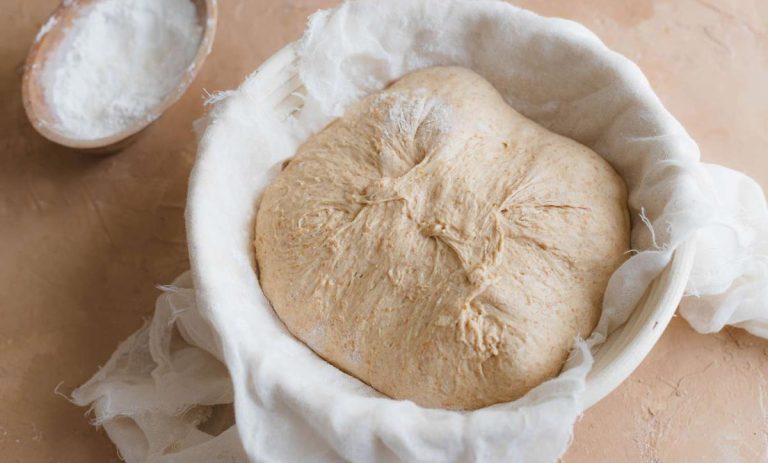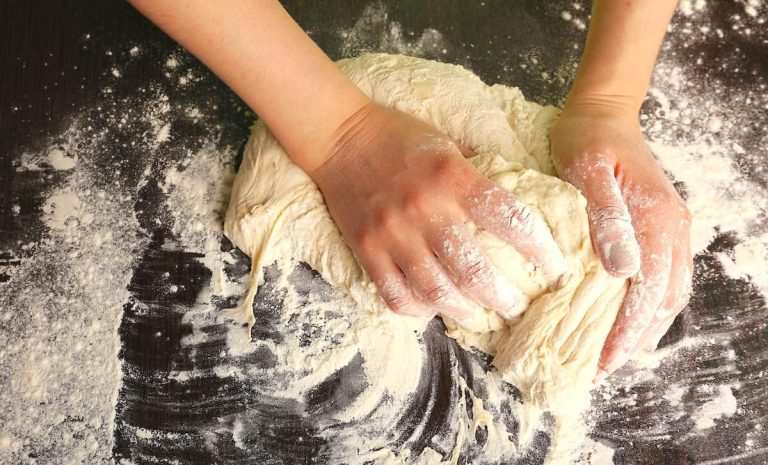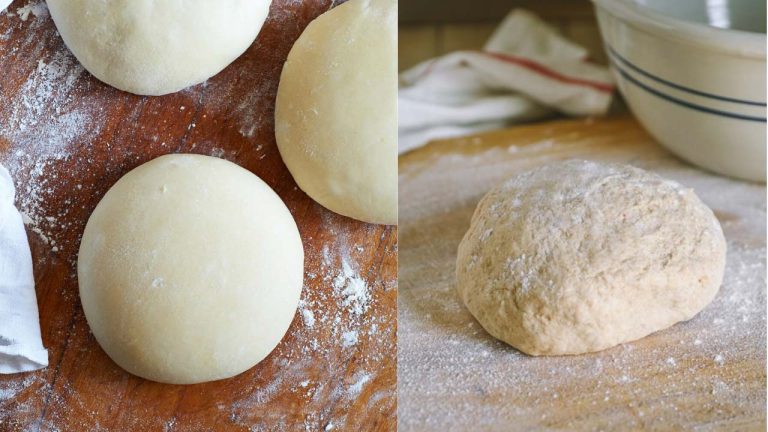Why Is My Bread Dough Not Rising?
Making homemade bread from scratch is one of the most satisfying things in the world. Homemade bread has better texture and taste than store-bought breads and the taste gets intensified because of the hard work you put into it. But all hard work can be wasted if the bread dough does not rise properly.
Many factors can cause the bread dough not to rise properly, but most of the time the fault is in the yeast. Old and dead yeast does not convert the sugar in the dough to ethanol and carbon dioxide which in turn does not form the bubbles inside the bread and prevents the bread from rising.
In this article, we will go through all of the potential reasons that can be behind your bread dough’s failure to rise properly, how to prevent such problems, and solutions if such problems occur.
Why Is My Bread Dough Not Rising?
Here we will discuss the reasons why bread doughs fail to rise. Your bread dough might fail to rise because of one of these issues or multiple reasons can be behind the problem. So make sure to properly identify the problems to not only fix the issue at hand but also to make sure that this does not happen again in the future.
The Yeast Is Too Old and Dead
Old and dead yeast is the most common reason behind the bread dough not rising properly. Always check and make sure that the yeast that you are using has time left before expiration dates. Even if the expiration date is overdue, the yeast can die because of temperature, humidity, bacteria, and other reasons.
This is why it is imperative to check if the yeast is okay to use. To test the yeast, take a cup of 38 C or 100 F degree warm water, dissolve one teaspoon of sugar, and dissolve one teaspoon of the yeast you will use in your bread. Cover the cup and set it aside for 15 minutes. The yeast is working properly if you see foaming or bubbling in the yeast mixture. Otherwise, the yeast is dead and you need to discard that yeast.
Even when you are sure that the yeast is good, it is wise to proof the yeast beforehand because all yeast tends to go bad suddenly.

The Water Is Too Hot
Another common reason why the dough will not rise is using too hot water to activate the yeast. Yeast is a living organism of the Fungi kingdom and like all other organisms, it also has a range of temperature where it thrives.
When you are preparing the yeast mixture, it is wise to warm the water a little because yeast gets activated faster in lukewarm water. But the yeast will die if you use water warmer than 45 C or 113 F.
Measure the temperature of the water before putting the dry yeast into it. You can also check the water by sticking your finger in it. The water is too hot if you cannot comfortably put your finger in the water.
Let the water cool down a little before adding the dry yeast to it. Yeast will take a longer time to get activated in colder water but it will die if you use too hot water.

Too Much Salt
Most bread recipes include salt for balancing the taste but you should not use too much salt. Never use salt while preparing the yeast mixture because salt will kill the yeast.
Only add salt with the flour in small quantities because too much salt will cause the water to get sucked out from the yeast cell and will kill it. This will prevent the bread dough from rising.

The Room Temperature Is Too Cold
Yeast requires a warm temperature to work its magic. The bread dough can fail to rise or rise too slowly if the temperature is too cold. This problem might occur more in the winter season when the room temperature is below 15 C or 59 F.
To prevent this problem, cover the bread dough well and put it in the oven with very low heat. Do not put too much heat as that will kill the yeast in the bread dough. You can also use bread dough rising containers to make sure that the temperature is not too cold.

Too Much Flour
Too much flour can also prevent the bread dough from rising properly. Too much flour means that there is not enough yeast to break down the sugar in the bread into ethanol and carbon dioxide which means that the bread dough will not rise properly. Make sure that you measure everything correctly and do not put too much flour in the bread dough.
Using Whole Grains Flour Instead of All-purpose Flour
Whole grains flour is healthier than all-purpose flour as it contains more fiber which is good for our digestive system but at the same time, whole grains do not have the necessary gluten that helps to raise the bread. Use both all-purpose flour and whole grains flour while making bread to avoid this problem.

The Mixture Is Too Dry
Yeast cannot make the bread dough rise if the mixture is too dry. The bubbles need to slowly build up and this can only happen if the bread dough is elastic enough. The bread dough will not rise properly if the mixture is too dry. So rub oil all around the surface of the bowl and on the bread dough to help it rise properly and do not use more flour than necessary.
Too Much Sugar
Too much sugar can also slow down the process as the sugar will absorb the moisture present in the dough and the mixture will become too dry for the yeast to effectively work in and cause it to inflate. So even though sugar helps the yeast to produce ethanol and carbon dioxide, too much of it can prevent the yeast from functioning properly.
You should use osmotolerant yeast which is a particular type of yeast that can work under dry conditions if you are baking something sweet and high in sugar quantity. This type of yeast can be found in the supermarket to raise extra dry dough.
What Happens if My Bread Doesn’t Rise Perfectly?
Your bread will not be soft as there will not be enough small air pockets forming in the dough if the bread dough does not rise perfectly. It will ruin the texture of the bread and the bread can even remain raw on the inside as heat will not enter the bread properly. Overall, your bread will be ruined if it does not rise properly.
How to Fix Dough That Won’t Rise?
How you will fix the dough will depend on the problem that is preventing the dough from rising. Kneading the bread increases the amount of gluten in the bread dough which in turn helps the bread to rise. So you can knead the bread more if you see that the bread is not rising properly.
However, kneading will not solve the problem if the yeast is dead. In this case, you will have to prepare a new good yeast mixture and knead the bread dough with this mixture and some flour.
Temperature and humidity can also be the reason why your bread dough is not rising. In that case, cover the bread dough well and keep it in a warm and dark place such as in the oven.
Sometimes the bread dough just requires some more time to rise. So be patient and wait half an hour to one hour to see if the bread dough has risen any higher.

Frequently Asked Questions
What Type of Flour Is Best for Bread Dough Rising?
All-purpose flour and bread flour are the best types of flour to use in bread as they contain high amounts of gluten which can easily be converted to ethanol and carbon dioxide. This helps the bread to rise faster. Whole grain flour such as barley, millet, rice flour, etc. is not suitable to be used in bread dough.
Can I Adjust the Rising Time if My Dough Seems Slow?
Yes, you can adjust the rising time by putting the bread dough in a warm and dark place. Yeast requires a warm temperature to work and sunlight hampers the growth of yeast cells. So put the bread dough in a warm and dark place to decrease the time it will take for the bread dough to rise.
Are There Any Tricks to Help My Dough Rise Faster?
Proof the yeast beforehand to make sure that the yeast is working properly and activate the yeast before you start kneading the bread. This will give the yeast a headstart and it will work faster to raise the bread. Another trick is to cover the bread dough with a moist towel to create a damp environment. Also, rub oil on the bowl and on the surface of the dough to help it rise faster.

How to Make Sure That the Yeast Is Working Properly?
Proofing the yeast is a very effective method to ensure that the yeast you are using is in good condition and can be used in making bread. To proof the yeast, take a cup of water and warm it to 38-42 C, dissolve one teaspoon of sugar, and dissolve the dry yeast in the sugar-water mixture. Cover it and set aside for 10-15 minutes.
The yeast is working properly if you see foams and bubbles forming on the surface of the mixture. This indicates that the yeast is active and it is converting the sugar in the mixture into ethanol and carbon dioxide which is coming out as bubbles from the mixture.
Conclusion
In most situations, you will find that old, dead, or inactive yeast is the reason why the bread is not rising properly. This is why it is important to not only buy good quality yeast but you should also store the yeast in an airtight container if you open the packet.
Also, remember to proof the yeast beforehand to be a hundred percent certain that the yeast that you are using is in good condition. Proofing the yeast will only take a few minutes which will save you from wasting an hour or so trying to bake bread with a dough that refuses to rise.







